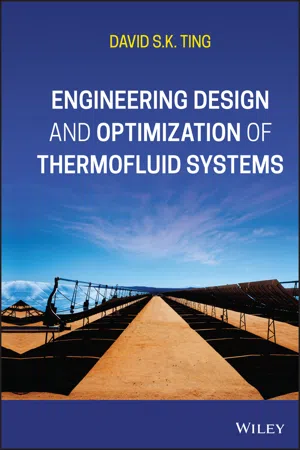
- English
- ePUB (mobile friendly)
- Available on iOS & Android
Engineering Design and Optimization of Thermofluid Systems
About This Book
A practical and accessible introductory textbook that enables engineering students to design and optimize typical thermofluid systems
Engineering Design and Optimization of Thermofluid Systems is designed to help students and professionals alike understand the design and optimization techniques used to create complex engineering systems that incorporate heat transfer, thermodynamics, fluid dynamics, and mass transfer. Designed for thermal systems design courses, this comprehensive textbook covers thermofluid theory, practical applications, and established techniques for improved performance, efficiency, and economy of thermofluid systems. Students gain a solid understanding of best practices for the design of pumps, compressors, heat exchangers, HVAC systems, power generation systems, and more.
Covering the material using a pragmatic, student-friendly approach, the text begins by introducing design, optimization, and engineering economics—with emphasis on the importance of engineering optimization in maximizing efficiency and minimizing cost. Subsequent chapters review representative thermofluid systems and devices and discuss basic mathematical models for describing thermofluid systems. Moving on to system simulation, students work with the classical calculus method, the Lagrange multiplier, canonical search methods, and geometric programming. Throughout the text, examples and practice problems integrate emerging industry technologies to show students how key concepts are applied in the real world. This well-balanced textbook:
- Integrates underlying thermofluid principles, the fundamentals of engineering design, and a variety of optimization methods
- Covers optimization techniques alongside thermofluid system theory
- Provides readers best practices to follow on-the-job when designing thermofluid systems Contains numerous tables, figures, examples, and problem sets
Emphasizing optimization techniques more than any other thermofluid system textbook available, Engineering Design and Optimization of Thermofluid Systems is the ideal textbook for upper-level undergraduate and graduate students and instructors in thermal systems design courses, and a valuable reference for professional mechanical engineers and researchers in the field.
Frequently asked questions
Information
1
Introduction
Chapter Objectives
- Understand what design and optimization of thermofluid systems mean.
- Differentiate engineering from science.
- Discern development, design, and analysis.
- Become familiar with the design process.
- Be aware of the existing books on thermofluid system design and/or optimization.
- Appreciate the organization and contents of the book.
Nomenclature
| HVAC | heating, ventilation, and air conditioning |
| Idir | direct radiation on a horizontal surface |
| KISS | keep it simple, stupid |
| LED | light‐emitting diode |
| PV | photovoltaic |
| UWCAES | underwater compressed air energy storage |
| X, x | (design) variables or influencing parameters |
| Y | a variable, the objective function |
1.1 What Are Design and Optimization of Thermofluid Systems?
the design and, subsequently, optimization of the design of engineering systems involving significant fluid flow, thermodynamics, and/or heat transfer.
- design
- optimization
- thermofluid1
- systems.2
- design is the creation of an engineering system which will provide the desired result, and
- optimization is taking the workable design one step further, attaining not just a better but the best design.
Example 1.1 Design a residential solar thermal energy storage system
Given
Find
Solution

Table of contents
- Cover
- Table of Contents
- Title Page
- Copyright
- Dedication
- Preface
- Acknowledgments
- 1 Introduction
- 2 Engineering Economics
- 3 Common Thermofluid Devices
- 4 Heat Exchangers
- 5 Equations
- 6 Thermofluid System Simulation
- 7 Formulating the Problem for Optimization
- 8 Calculus Approach
- 9 Search Methods
- 10 Geometric Programming
- Appendix: Sample Design and Optimization Projects
- Index
- End User License Agreement